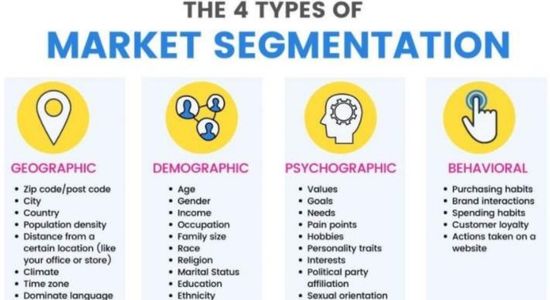This article will discuss nine effective email marketing or segmentation strategies that every marketer should know, including demographic, behavioural, psychographic, firmographic, technographic, RFM, and personalization segmentation.

Demographic Segmentation
A. Age
Segmenting emails based on the recipient’s age can help marketers tailor their messages to appeal to a specific age group. For example, older generations may respond differently to a message than younger generations.
B. Gender
Segmenting by gender allows marketers to send gender-specific promotions and messages. For example, a clothing retailer can send men’s or women’s clothing promotions to the respective segments.
C. Income
Segmenting by income allows marketers to send relevant promotions and messages based on the financial means of the recipient. For example, luxury brands can target high-income segments with high-end products.
D. Location
Segmenting by location enables marketers to send location-specific promotions and messages. For example, a restaurant can send promotions for a new menu item to recipients in a specific city.

Behavioural Segmentation
A. Purchase History
Segmenting based on purchase history allows marketers to send targeted promotions and messages based on a recipient’s past purchasing behaviour. For example, a retailer can send promotions for similar products to customers who have previously purchased similar items.
B. Web Behavior
Segmenting by web behaviour involves dividing the email list based on a recipient’s actions on a company’s website. For example, a marketer can send targeted messages to those who have visited a specific page on the website.
C. Engagement Metrics:
Segmenting by engagement metrics involves dividing the email list based on how engaged a recipient is with a company’s previous emails. For example, a marketer can send targeted messages to those with high open and click-through rates on previous emails.
Psychographic Segmentation
A. Interests and Hobbies:
Segmenting by interests and hobbies allows marketers to send targeted promotions and messages based on a recipient’s interests. For example, a sports retailer can send promotions for sporting equipment to recipients who have expressed an interest in a specific sport.
B. Values and Attitudes:
Segmenting by values and attitudes enables marketers to send targeted promotions and messages that align with the values and attitudes of the recipient. For example, a natural products retailer can send promotions for eco-friendly products to recipients who value sustainability.
C. Personality Traits:
Segmenting by personality traits involves dividing the email list based on a recipient’s personality traits, such as introversion and extroversion. For example, a marketer can send targeted messages to introverts with a calm and soothing tone, while messages to extroverts may have a more energetic tone.
Firmographic Segmentation
A. Industry
Segmenting by industry allows marketers to send targeted promotions and messages to recipients in specific industries. For example, a software company can send promotions for enterprise software to recipients in the finance industry.
B. Company Size
Segmenting by company size involves dividing the email list based on the size of a recipient’s company. For example, a marketer can send targeted messages to small businesses offering products and services specifically designed for their needs.
C. Job Title
Segmenting by job title enables marketers to send targeted promotions and messages to specific job functions within a company. For example, a marketer can send targeted messages to HR managers with promotions for HR software.
D. Business Model
Segmenting by business model involves dividing the email list based on the type of business a recipient operates. For example, a marketer can send targeted messages to online retailers with promotions for e-commerce software.
Technographic Segmentation
A. Technology Usage
Segmenting by technology usage allows marketers to send targeted promotions and messages based on a recipient’s technology usage. For example, a marketer can send promotions for mobile devices to recipients who frequently use their smartphones.
B. Technology Stack
Segmenting by technology stack involves dividing the email list based on the specific technologies a recipient’s company uses. For example, a marketer can send targeted messages to companies using a specific CRM offering promotion for integrations with that CRM.
C. Adoption Stage
Segmenting by adoption stage involves dividing the email list based on a recipient’s company’s adoption stage of a specific technology. For example, a marketer can send targeted messages to companies in the early stages of adopting a new technology offering educational resources and guidance.
RFM Segmentation
RFM stands for Recency, Frequency, and Monetary value and is a customer segmentation technique based on three key metrics:
A. Recency
The length of time since a recipient’s last purchase or engagement.
B. Frequency
The number of purchases or engagements a recipient has made.
C. Monetary Value
The total amount a recipient has spent or the value of their engagement.
RFM segmentation allows marketers to target high-value customers who have made recent purchases and have a high engagement and spending history.
Personalization Segmentation
Personalization segmentation involves using personal information such as name, location, and interests to create a more personalized experience for the recipient.
A. Personalized Greeting
Including a personalized greeting with the recipient’s name in the email subject line or body can increase open rates and engagement.
B. Location-Based Promotions
Segmenting by location and sending targeted promotions based on the recipient’s location can increase relevance and personalization. For example, a retailer can send promotions for products available in a specific store location.
C. Personalized Product Recommendations:
Segmenting by purchase history and sending personalized product recommendations based on a recipient’s previous purchases can increase relevance and personalization.
D. Behavioral Triggered Emails
Using behavioural data to trigger personalized email marketing campaigns can increase relevance and personalization. For example, a retailer can send a personalized follow-up email to a recipient who abandoned a shopping cart on their website.
Confused Genius and Marketing
Confused Genius is an email marketing automation platform to help marketers segment their email lists and personalize their campaigns. With Confused Genius, marketers can:
- Segment their email list based on demographics, behavior, psychographics, firmographics, technographics, RFM, and personalization data.
- Use AI-powered personalization to create highly relevant and personalized email campaigns.
- Automate email marketing campaigns based on behaviour and other triggers to save time and increase relevance.
- Measure and optimize their email marketing campaigns using advanced analytics.
Confused Genius can help marketers increase the relevance and personalization of their email marketing campaigns, leading to higher open rates, engagement, and conversions.

